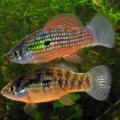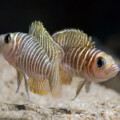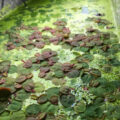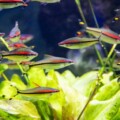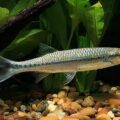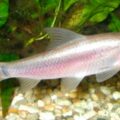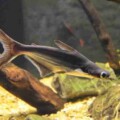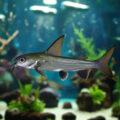The Harlequin Shark Minnow species is an underappreciated multi-patterned bottom-dweller that can liven up your aquarium community. This overview explains their complex maintenance, tank setup, feeding, and breeding needs for maximizing their lifespan.
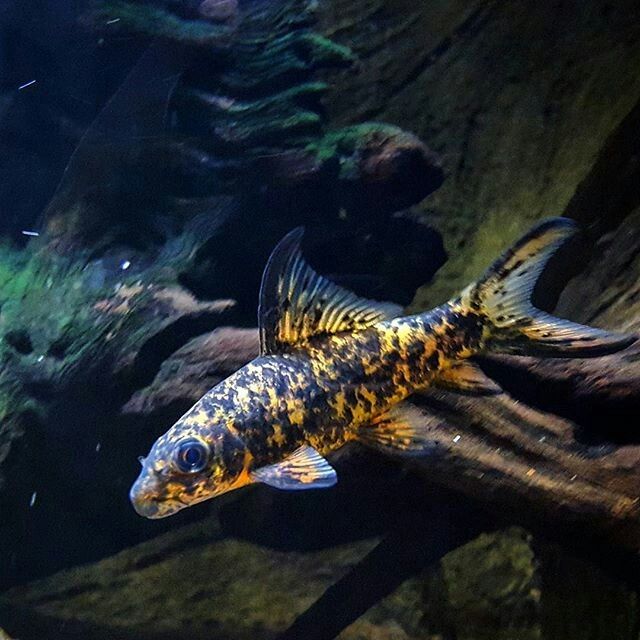
Introduction
Do you want your aquarium to stand out with a rare aquarium bottom dweller? Then, you should consider the Harlequin Shark freshwater fish.
Although it’s less popular than most aquarium species, this medium-sized species has a bold coloration that will highlight any substrate.
Besides its distinctive appearance, the Harlequin Shark is a semi-aggressive, active fish that needs extra attention and care. So, this Labeo cyclorhynchus species profile is for expert and intermediate aquarists who enjoy having pets with personalities.
Author’s Note: Check out our post on the 14 Small & Big Freshwater Pet Sharks for more Freshwater Home Aquarium compatible shark lookalikes.
Wild Origins and Natural Habitat
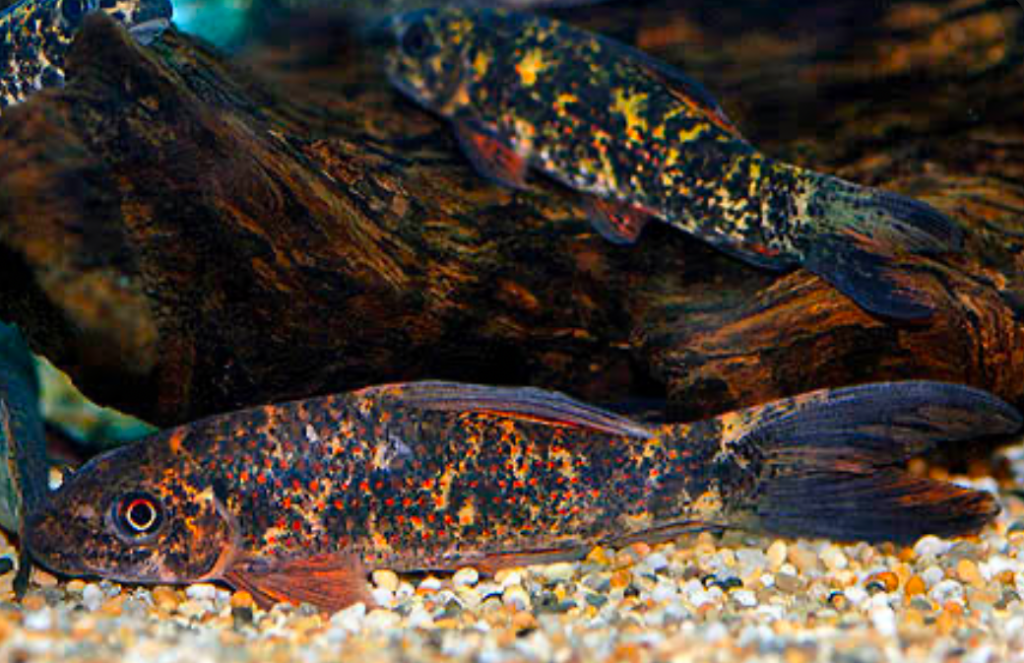
Before domesticating this fish, you must learn about the Labeo cyclorhynchus’ natural habitat. This information will help you understand their origins and provide a perfect aquarium for them outside the wild.
I can now tell you that the Harlequin Shark is an African river fish species from the Congo Basin. Its natural habitat includes fast-flowing rivers, thick vegetation, and driftwood.
This next part of the guide will show how you can make Harlequin Shark a Congo River aquarium fish. You can recreate the Congo Basin’s ecosystem within your tank with heavily oxygenated waters, dense leaf litter, and submerged driftwood to feel like home for your Harlequin Shark.
Setting Up the Ideal Aquarium for a Harlequin Shark
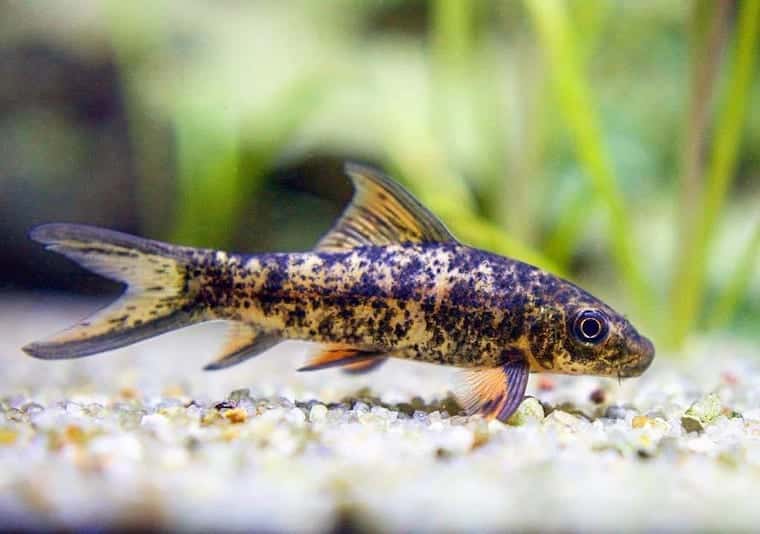
You must meet some essential Harlequin Shark tank requirements when designing your pet’s ideal aquarium or outdoor pond.
A suitable habitat must have plenty of floor space, hiding areas, moderate to strong filtration, and a secure lid. Here’s a more detailed Labeo cyclorhynchus setup guide up next.
Tank Size
Get a tank that can hold at least 55 gallons of water for a single adult Harlequin Shark because they grow up to 6 inches (15cm) long.
Decor & Layout
Designing an African fish biotope aquarium involves multiple layers. You’ll start from the floor to the top. So here’s what to do.
Cover the floor with a substrate like fine sand or smooth, rounded pebbles. These are safe and gentle on your Harlequin Shark’s body, considering they’ll spend most of their time at the bottom.
Next is the vegetation within the tank. Use a mixture of aquarium plants, from tall Java ferns to short moss and leaf litter, for density.
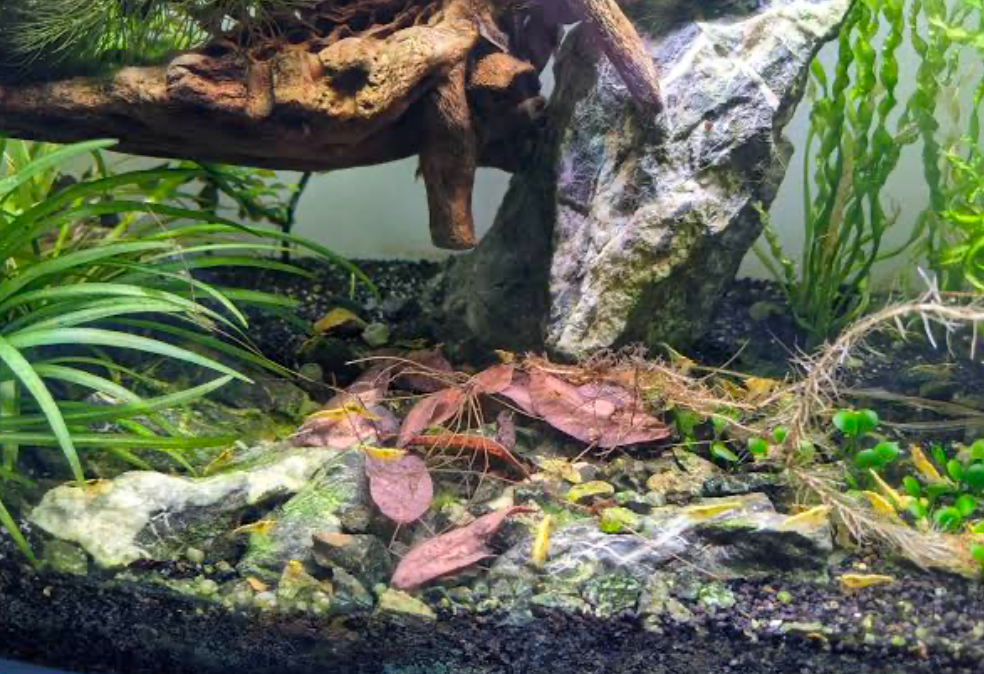
Add smooth rocks and caves as hiding spots and accentuate them with driftwood tunnels.
Harlequin Sharks need subdued lighting in the tank to prevent eye irritation. Place moderate to low LED lighting behind tall plants for the best results.
Finally, for the top, use floating aquarium plants like Frogbits and a secure, breathable lid to keep them from jumping out when they swim to the surface.
Author’s Note: Check out our post on the 17 Floating Aquarium Plants for Beginner Freshwater Aquarists for plant recommendations!
Filtration Tips
Despite Harlequin Sharks thriving in fast-moving waters, keep a moderate flow filtration system to maintain excellent water quality without stressing your pets.
Recognizing the Appearance of Labeo Cyclorhynchus
Because this species is a lesser-known fish, identifying Labeo cyclorhynchus may be challenging. However, knowing its physical characteristics and other unique traits can make it easier.
Instruct to describe its dark, velvety black body with contrasting white or orange blotches, firm structure, and sucker-like mouth. Include adult size (up to 6 inches) and body posture.
Color Pattern
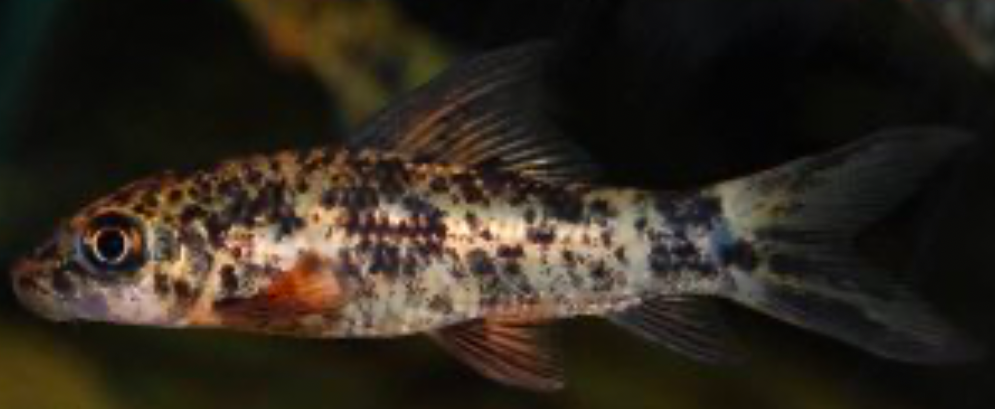
The Harlequin Shark is a patterned freshwater shark with a dark, velvety black body highlighted by white or orange blotches. Depending on the fish, these blotches may be bold and marbled or small and dotted.
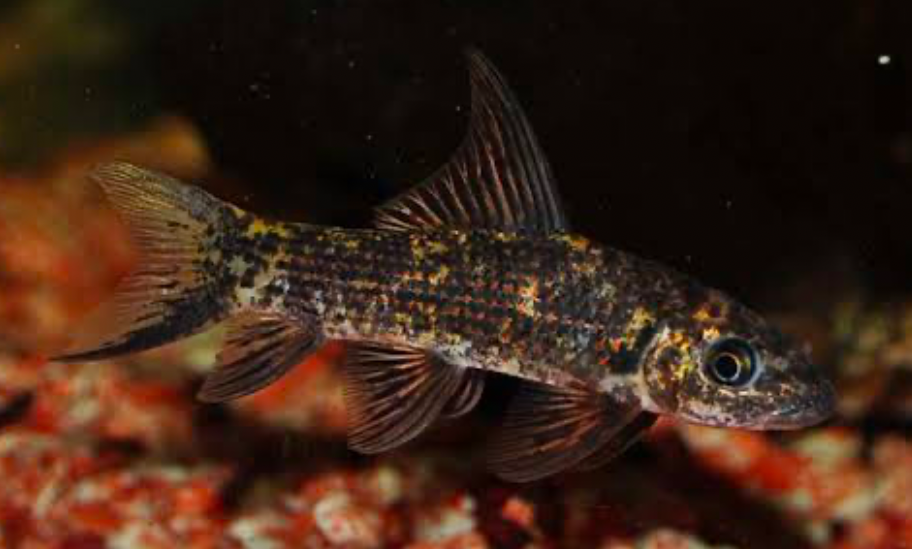
The patterns give this minnow different looks, from bright orange patchworks overshadowing their dark bases to dull white spots barely highlighting their base colors.
A Harlequin Shark coloration distinguishes juveniles from adults because it gets duller as they mature.
Unique Traits
Other unique features for identifying Harlequin Sharks include their personality and sexual dimorphism.
The females of this species have rounder bodies than the males, especially during breeding season. However, both sexes have curved, large dorsal fins, bold lips, and two barbels.
Harlequin Sharks are also territorial, strong swimmers who prefer lower tank levels.
Diet and Feeding Schedule for Health and Color
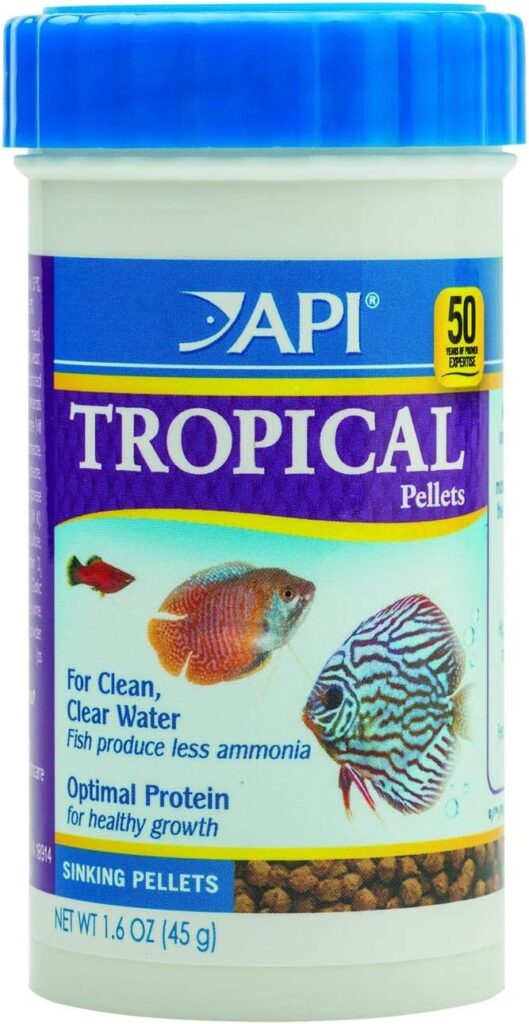
Found On Amazon
Harlequin Sharks are omnivorous fish who prefer a protein-leaning diet, including commercial high-quality sinking pellets, algae wafers, and insect larvae. They need these varied foods for rich Labeo cyclorhynchus nutrition which ensures healthy growth and development while avoiding malnutrition.
Feeding Frequency
Follow this Harlequin Shark feeding routine to ensure your pet gets healthy food.
Feed them staples 1–2 times daily and 3 times for juveniles in small portions they can consume within 3 minutes.
It’ll reduce waste, water pollution, obesity, and other overfeeding issues like bloating.
Diet Suggestions
This is a bottom-feeder fish diet plan you can use to ensure your Harlequin Shark gets all the nutrients it needs.
- Staples: Bloodworms, sinking wafers, and insect-based pellets.
- Supplements: vegetables like shelled peas,
Sinking food ensures your pets can access their meals since they feed at the bottom by scavenging and foraging.
Author’s Note: For more on feeding your aquatic pets check out The Ultimate Guide to Fish Food: Pros and Cons & Best Choices!
Tank Mate Compatibility and Behavior Considerations
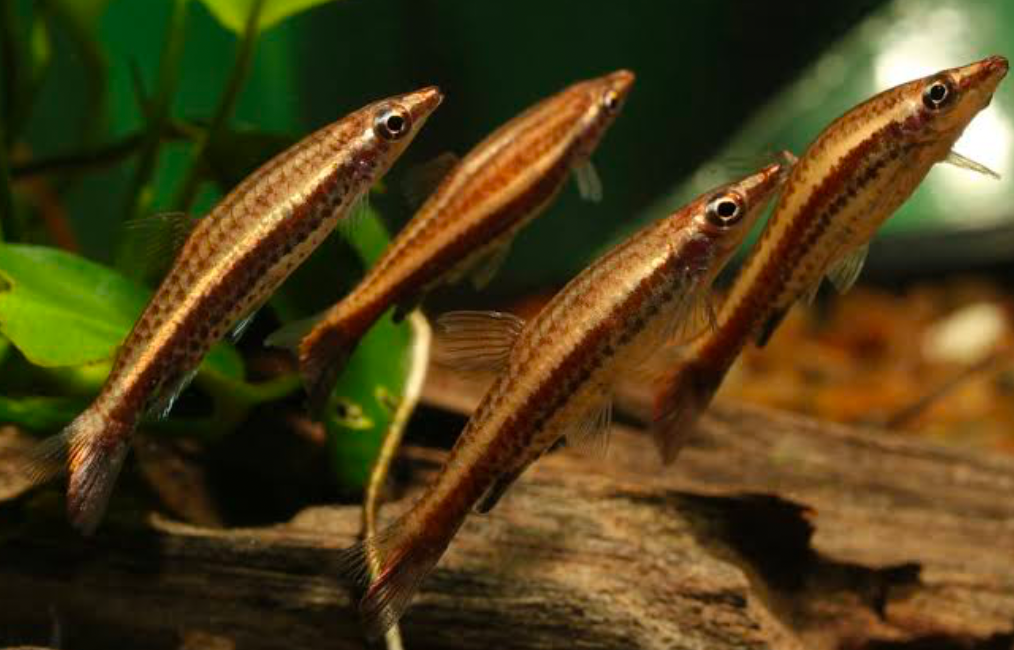
Despite being a bottom-territory fish, the Harlequin Shark sometimes swims to the mid-level and top of the aquarium.
While exploring their environments, this species can become semi-aggressive and show territorial behavior towards other tank mates. So, do a semi-aggressive fish compatibility test before mixing Harlequin Sharks with other species.
Compatible Species
Some compatible Labeo cyclorhynchus tank mates include Congo tetras, rainbowfish, and upper-swimming barbs like Silver Dollar and Brown Pencilfish.
Tankmate Species To Avoid
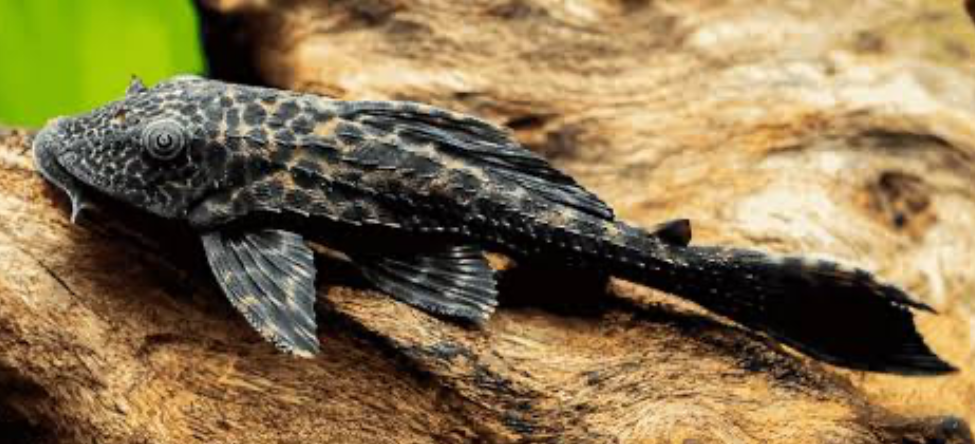
Harlequin Shark minnows are often aggressive towards other bottom dwellers or similar-shaped fish, so avoid Loaches, plecos, and other Labeo species.
Also, keep slow-bottom fish away from them to prevent predatory behaviors.
Breeding in Captivity: Is It Possible?
For Labeo species reproduction, you’d need a large commercial farm after extensive research on breeding Harlequin Sharks at home.
It’s not that fishkeeping enthusiasts haven’t tried, but Labeo Sharks are aggressive and rarely mate outside their natural habitat. If this ever happened, there’s simply no spawning data to back it up.
Breeding Status
Unfortunately, there’s no reliable documentation on Harlequin Shark breeding attempts because of their rarity. Most fish keepers and owners of this species caught them in the wild as juveniles or adults.
Spawning Behavior
Despite the limited breeding data, there have been speculations about Harlequin Sharks having rare freshwater fish spawning habits like scattering their eggs in the wild to develop without parental guidance.
Common Health Risks and Preventative Measures
This guide contains Harlequin Shark health tips for ensuring wellness in home aquariums or outdoor ponds.
If you don’t follow them, you risk your pets experiencing common concerns such as territorial stress, minor fin injuries, and ich.
Luckily for your pets, you can achieve Labeo fish stress management by providing a stable tank layout, consistent water parameters, and other preventative measures.
Preventative Practices
Some aquarium injury prevention tips include giving your Harlequin Shark a safe hiding spot and avoiding tankmate conflicts by pairing them with compatible species only. Scroll up for tips on choosing the best tank mates for Harlequin Sharks.
Warning Signs
Look out for warning signs of illnesses, such as excessive hiding, chasing other tank mates, nursing torn fins, and loss of color from malnutrition.
Most of these symptoms are environmentally triggered. So, quarantine the sick fish and improve your tank condition. If symptoms persist, visit a certified vet for a diagnosis and medication prescription.
Lifespan and Long-Term Needs
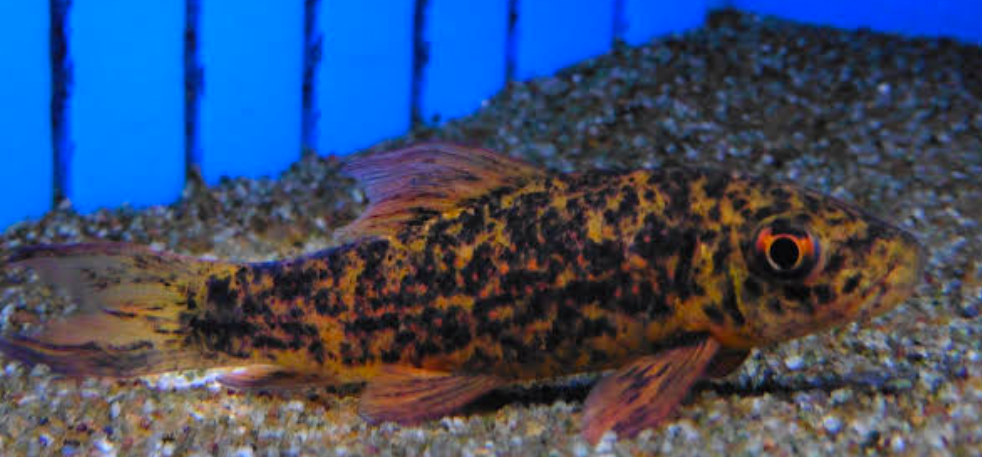
Proper care, as provided in this guide, can maximize your Labeo cyclorhynchus’ lifespan for 6–10 years.
That includes long-term aquarium planning, such as providing ample swimming space, minimal competition from tank mates, and long-term planning for solo housing where necessary.
Growth & Size
Since they grow up to 6 inches, a medium-sized 55-gallon minimum tank is ideal for their housing. Upgrade the tank if you add more tank mates, whether they’re also Harlequin Sharks or other species.
Care Commitment
Experienced hobbyists with medium to large aquariums are better able to handle the complex Harlequin Shark care routine. These enclosures provide enough room for species-specific setups with essentials like filtration systems, heaters, and biotope decor.
Conclusion: A Striking Choice for Advanced Aquarists
Would you add this rare African freshwater fish to your aquarium? Or are you still skeptical about the Harlequin Shark minnow? You can decide after reading this Labeo cyclorhynchus profile summary.
Harlequin Shark’s bold patterned scales, fascinating behavior, and care needs make them a worthy bottom-dwelling pet for interactive aquariums.
It’s a rewarding fish for aquarists who enjoy unique, semi-aggressive bottom-dwellers in large, carefully curated tanks.
Did you enjoy reading this Harlequin Shark aquarium overview? Let’s hear your comments in the box below.

